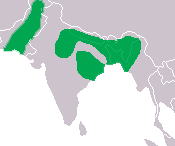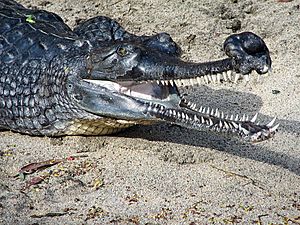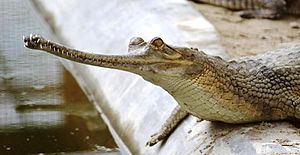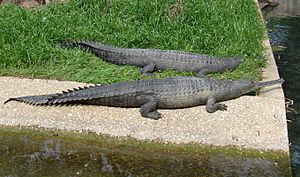Gharial facts for kids
Quick facts for kids Gharial |
|
|---|---|
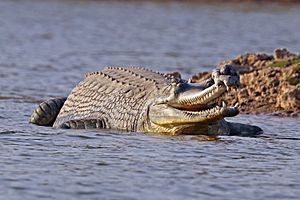 |
|
| Male gharial | |
 |
|
| Female and juvenile gharial | |
| Conservation status | |
| Scientific classification | |
| Genus: |
Gavialis
|
| Species: |
gangeticus
|
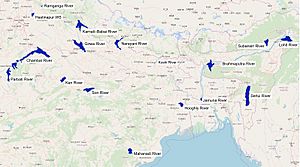 |
|
The gharial (Gavialis gangeticus), also known as the gavial or fish-eating crocodile, is a unique type of crocodilian. It belongs to the family Gavialidae and is one of the longest living crocodilians. Adult females are about 2.6 to 4.5 meters (8.5 to 14.8 feet) long. Males are even bigger, reaching 3 to 6 meters (9.8 to 19.7 feet).
Gharials have a special bump at the end of their snout. This bump looks like an earthenware pot called a ghara, which is where the name "gharial" comes from. Their long, thin snout and 110 sharp, interlocking teeth make them perfect for catching fish.
Gharials likely first appeared in the northern Indian subcontinent. Fossils of gharials have been found in rocks from the Pliocene period. Today, they live in rivers across the northern plains of the Indian subcontinent. They spend most of their time in water, only coming out to warm up in the sun or to build nests on sandy riverbanks.
Adult gharials mate at the end of the cold season. Females gather in spring to dig nests. They lay between 20 and 95 eggs in these nests. The mothers guard their nests and the young that hatch before the monsoon season begins. Young gharials stay and hunt in shallow water during their first year. As they grow, they move to deeper parts of the river.
The number of wild gharials has dropped a lot since the 1930s. Today, they live in only 2% of the areas they once did. Since the early 1980s, conservation programs in India and Nepal have worked to release gharials raised in captivity back into the wild. However, their homes are still threatened by sand mining and farms. Also, there are fewer fish for them to eat, and harmful fishing methods continue to be a problem. Because of these threats, the gharial has been listed as critically endangered on the IUCN Red List since 2007.
The oldest pictures of gharials are about 4,000 years old. They were found in the Indus Valley. In Hindu beliefs, the gharial is seen as the animal that carries the river goddess Gaṅgā. People living near rivers used to believe gharials had special powers. They even used parts of the gharial's body in traditional medicines.
Contents
Where Gharials Live
Gharials live in the northern Indian subcontinent. They are found in:
- India (their numbers are small but growing)
- Nepal
- Bangladesh (almost gone)
- Pakistan (almost gone)
- Bhutan (almost gone)
- Myanmar (possibly gone)
They usually live in big river systems like the Indus (in Pakistan), the Brahmaputra (in Bangladesh, Bhutan, and northeastern India), the Ganges (in Bangladesh, India, and Nepal), and the Mahanadi (in India). A few might also be found in the Kaladan and Ayeyarwady River in Myanmar. In some areas, they share their habitat with the mugger crocodile and the saltwater crocodile.
Gharial Habitat
Gharials live in rivers. They prefer calm, deep areas within fast-moving rivers. Their bodies are not well-suited for walking on land. The only times a gharial leaves the water are to warm itself in the sun or to build nests on the sandy banks of the rivers.
Appearance and Features
The gharial has a very long, thin snout. This is what makes it look different from most other crocodilians. The only other species with a similar snout is the False gharial (Tomistoma schlegelii), which is a close relative. As a gharial gets older, its snout becomes even thinner.
Male gharials develop a round, bulb-like growth on the tip of their snout. This is called a 'ghara', named after an Indian pot. Only adult males have this. They use the ghara to make a deep humming sound when they vocalize. It also helps them attract females during mating. During their mating ritual, males use the ghara to make bubbles in the water.
Their long jaws are full of many sharp, interlocking teeth. This is perfect for their diet, which is mostly fish when they are adults. Gharials are among the largest crocodilian species, often reaching 5 to 6 meters (16 to 20 feet) in length. Some reports even mention 7-meter (23-foot) animals, but these are not confirmed.
Gharials cannot lift their bodies off the ground to walk like other crocodiles. They can only push their bodies forward by sliding on their bellies. However, in the water, the gharial is one of the fastest and most agile crocodiles. Their tail is very strong and flattened on the sides, more so than other crocodiles. This helps them be excellent swimmers.
The gharial's front teeth are the largest. Their nasal opening is smaller than some other skull features. The lower jaw is very long. Gharials have a shield of bony plates, called scutes, on their back. They also have two small scutes behind their head.
Their outer toes are two-thirds webbed, while the middle toe is one-third webbed. This helps them swim. Adult gharials are usually dark olive green. Young gharials are pale olive with dark brown spots or stripes.
What Gharials Eat
Young gharials eat insects, larvae, and small frogs. Adult gharials eat almost only fish. Their long, narrow snouts are perfect for catching fish. They can quickly swipe their heads through the water to snap up fish. Their many needle-like teeth are great for holding onto slippery fish.
Are Gharials Dangerous to Humans?
No, gharials are not man-eaters. Even though they are huge, their thin, delicate jaws cannot eat large animals, including humans. The idea that gharials eat people might come from their similar look to other crocodiles. Also, jewelry has sometimes been found in their stomachs. However, gharials might have swallowed this jewelry while eating dead animals or perhaps to help with digestion or floating.
Gharial Reproduction and Life Cycle
The mating season for gharials is from November through January. Females lay their eggs during the dry season in March, April, and May. This is because the rivers shrink a bit during the dry season, making sandy riverbanks available for nesting.
A female gharial digs a hole and lays between 30 and 50 eggs inside. She then carefully covers the nest. After about 90 days, the young gharials hatch. There is no record of the mother helping the babies get into the water. This is probably because her jaws are not suited for carrying the young due to her needle-like teeth. However, the mother does protect her young in the water for a few days until they learn to find food for themselves.
Conservation Efforts
In the 1970s, the gharial was almost extinct. Even today, it is on the critically endangered list. Thanks to the hard work of environmentalists and several governments, the threat of extinction has been reduced. There is hope for the species because of conservation programs started in 2004.
Full protection was given to gharials in the 1970s to stop poaching. While these rules were slow to start, India now has 9 protected areas for gharials. These areas are part of programs where eggs collected from the wild are raised in captivity. This helps more young gharials survive because it protects them from natural predators. Once they are bigger, they are released back into the wild. The first release happened in 1981.
More than 3,000 gharials have been released through these programs. The wild population in India is now estimated to be around 1,500 animals. There are perhaps another 100 to 200 gharials in other parts of their range.
In 2007, the gharial's status changed from Endangered to Critically Endangered on the Red List of endangered species. This list is put out by the World Conservation Union. This means the gharial qualifies for protection under CITES (Convention on International Trade of Endangered Species) Appendix II, which controls trade of endangered animals.
Gharial Family Tree
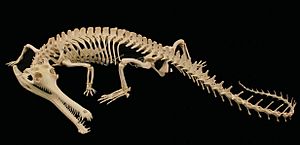
Scientists group the gharial and its extinct relatives in a few ways:
- Some scientists see the three main groups of crocodilians as separate families. In this view, the gharial is one of two members of the Gavialidae family. The other families are Crocodylidae (crocodiles) and Alligatoridae (alligators and caymans).
- Other scientists put all three groups together in one big family called Crocodylidae. Then, the gharial belongs to a smaller group called the Gavialinae.
- Scientists who study fossils often use the term Gavialoidea to talk about the long history of gharial-like creatures.
Studies using genetic evidence have shown that the gharial and the false gharial (Tomistoma) are closely related. They are now often placed together in the same family.
Gharials are also known by many other names, including Indian gharial, Indian gavial, Fish-eating crocodile, Gavial del Ganges, Long-nosed crocodile, Bahsoolia, Nakar, Chimpta, Lamthora, Mecho Kumhir, Naka, Nakar, Shormon, Thantia, Thondre, and Garial.
Other Pages to See
Images for kids
-
Gharials in the Gharial Conservation and Breeding Center at Chitwan National Park
-
A miniature illustration of the Baburnama showing a gharial, ca. 1598, National Museum, New Delhi
See also
 In Spanish: Gavial para niños
In Spanish: Gavial para niños



